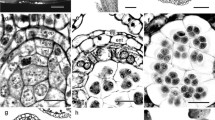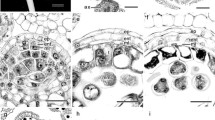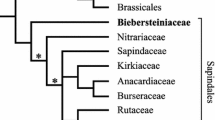Summary
Ovule development and gynosporogenesis (megasporogenesis) of two Rubiaceae, Chomelia obtusa (Cinchonoideae–Guettardeae) and Ixora coccinea (Ixoroideae–Ixoreae) were studied. Based on the new results it is proposed that the Ixora type’ of ovule development is established because of the convex nucellus and the presence of several archesporial cells. This result supports the close relationships of Cinchonoideae and Ixoroideae established by molecular systematic studies.
Similar content being viewed by others
References
Andersson L (1992). A provisional checklist of neotropical Rubiaceae. Scr Bot Belg 1: 1–199
Andersson L and Rova JHE (1999). The rps 16 intron and the phylogeny of the Rubioideae (Rubiaceae). Pl Syst Evol 214: 161–186
Andreasen K and Bremer B (2000). Combined phylogenetic analysis in the Rubiaceae–Ixoroideae: morphology, nuclear and chloroplast DNA data. Amer J Bot 87: 1731–1748
Andreasen K, Baldwin BG and Bremer B (1999). Phylogenetic utility of the nuclear rDNA ITS region in subfamily Ixoroideae (Rubiaceae): comparisons with cpDNA rbcL sequence data. Pl Syst Evol 217: 119–135
Andronova NN (1977). On the structure of the ovule of Rubiaceae. Bot Zeitg 62: 1461–1469
Andronova NN (1988). Comparative characteristics of the ovule structure of some Rubieae species (Rubiaceae). Bot Zeitg 73: 674–682
Bouman F (1984). The ovule. In: Johri, BM (ed) Embryology of angiosperms, pp 123–157. Springer, Berlin
Bouman F and Schier S (1979). Ovule ontogeny and seed coat development in Gentiana, with a discussion on the evolutionary origin of the single integument. Acta Bot Neerl 28: 467–478
Bremer B (1996). Phylogenetic studies within Rubiaceae and relationships to other families based on molecular data. Opera Bot Belg 7: 33–50
Bremer B, Andreasen K and Olsson D (1995). Subfamilial and tribal relationships in the Rubiaceae based on rbcL sequence data. Ann Missouri Bot Gard 82: 383–397
Bremer B and Thulin M (1998). Collapse of Isertieae, re-establishment of Mussaendeae and a new genus of Sabiceeae (Rubiaceae); phylogenetic relationships based on rbcL data. Pl Syst Evol 211: 71–92
De Candolle AP (1830) Rubiaceae. In: Prodomus systematis naturalis regni vegetabilis, vol 4. Treuttel et Würtz, Paris, pp 341–621
Block P (1995). Ovary, seed and fruit of Rutidea (Rubiaceae, Pavetteae). Pl Syst Evol 196: 1–17
Block P (1998). The African species of Ixora (Rubiaceae–Pavetteae). Opera Bot Belg 9: 1–218
De Toni KLG and Mariath JEA (2004). Desenvolvimento do rudimento seminal em Borreria verticillata (L.) G.Mey. (Rubiaceae–Rubioideae–Spermacoceae). Rev Bras Bot 27: 185–192
Faber FCV (1912). Morphologisch-physiologische Untersuchungen an Blüten von Coffea-Arten Ann. Jard Bot Buitenzorg 2: 59–160
Fagerlind F (1937). Embryologische, zytologische und bestäubungsexperimentelle Studien in der Familie Rubiaceae nebst Bemerkungen über einige Polyploiditätsprobleme. Acta Horti Bergiani 2: 196–470
Farooq M (1959). The embryology of Borreria hispida (Spermacoce hispida): a reinvestigation. J Ind Bot Soc 38: 280–287
Fosberg FR and Sachet M (1989). Lectotypification of Ixora coccinea L. (Rubiaceae). Taxon 38: 486–489
Galati GG (1991). Estúdios embriológicos em la tribu Spermacoceae (Rubiaceae). Parte I: Anatomia floral. Megasporogénesis. Megagametogénesis. Bol Soc Arg Bot 27: 7–20
Ganapathy PM (1956). Floral morphology and embryology of Hydrophylax maritima. J Madras Univ 26: 263–275
Gerrits PO and Smid L (1983). A new, less toxic polymerization system for the embedding of soft tissues in glycol methacrylate and subsequent preparing of serial sections. J Microsc 132: 81–85
Hayden MV (1968) Systematic morphological study of New World rubiaceous seeds (Rubioideae sensu Bremekamp). PhD dissertation. Saint Louis University, Saint Louis, USA
Herr JM (1984). Embryology and taxonomy. In: Johri, BM (ed) Embryology of angiosperms. pp 647–696, springer, Berlin
Husain T and Paul SR (1988). A cladistic analysis of Indian species of Ixora L. (Rubiaceae). Feddes Repert 99: 497–501
Igersheim A and Robbrecht E (1993). The character states and relationships of the Prismatomerideae (Rubiaceae–Rubioideae). Comparisons with Morinda and comments on the circumscription of the Morindeae s.str. Opera Bot Belg 6: 61–79
Inamuddin M and Farooq M (1984). The embryology of Richardia brasiliensis Gomes (syn. Richardsonia pilosa HB & K.) (Rubiaceae) – a reinvestigation. Pak J Bot 16: 139–144
Johri MB, Ambegaokar KB and Srivastava PS (1992). Comparative embryology of angiosperms. Springer, Berlin
Lloyd FE (1899). The comparative embryology of the Rubiaceae. Mem Torrey Bot Club 8: 1–26
Lloyd FE (1902). The comparative embryology of the Rubiaceae. Mem Torrey Bot Club 8: 27–111
Mariath JEA and Cocucci AE (1997). The ovules of Relbunium hypocarpium in the context of the Rubiaceae. Kurtziana 25: 141–150
McDowell E and Trump B (1976). Histological fixatives for diagnostic light and electron microscopy. Arch Pathol Lab Med 100: 405–414
Netolitzky F (1926) Anatomie der Angiospermen–Samen. In: Linsbauer K (ed) Handbuch der Pflanzenanatomie, vol 10, 2(2). Gebr. Borntraeger, Berlin
O’Brien TP, McCully ME (1981) The study of plant structure: principles and selected methods. Termarcarphi Pty, Melbourne, 345 pp
Puff C and Robbrecht E (1989). A survey of the Knoxieae (Rubiaceae–Antirheoideae). Bot Jahrb Syst 110: 511–558
Raghavan TS and Srinivasan AR (1941). Studies in Rubiaceae. II. Spermacoce hispida Linn., Guettarda speciosa Linn. and some cytomorphological considerations. Proc Indiana Acad Sci 14: 412–426
Robbrecht E (1988). Tropical woody Rubiaceae. Characteristic features and progressions. Contributions to a new subfamilial classification. Opera Bot Belg 1: 1–271
Robbrecht E and Puff C (1981). Mericocalyx Bamps, synonymous with Otiophora Zucc. (Rubiaceae). Bull Jard Bot Nat Belg 51: 143–151
Rutishauser A (1982) Introducción a la embriología de la reproducción de las angiospermas. Editorial Hemisferio Sur S. A., Buenos Aires
Rutishauser R, Ronse De Craene LP, Smets E and Mendoza-Heuer I (1998). Theligonum cynocrambe: developmental morphology of a peculiar rubiaceous herb. Pl Syst Evol 210: 1–24
Schleiden MJ (1837). Einige Blicke auf die Entwicklungsgeschichte des vegetabilischen Organismus bei den Phanerogamen. Arch Naturgesch 1: 289–414
Shamrov II (1998). Ovule classification in flowering plants – new approaches and concepts. Bot Jahrb Syst 120: 377–407
Shivaramiah G and Ganapathy PM (1961). A contribution to the embryology of Knoxia corymbosa. Curr Sci 30: 190–191
Shivaramiah G and Dutt RC (1964). A contribution to the embryology of Rondeletia amoena. Curr Sci 33: 280–281
Steyermark JA (1974). Rubiaceae. Flora de Venez 9: 478–495
Svoma E (1991). The development of the bicarpellate gynoecium of Paederia L. species (Rubiaceae–Paederieae). Opera Bot Belg 3: 77–86
Verdcourt B (1958). Remarks on the classification of the Rubiaceae. Bull Jard Bot Brux 28: 209–290
Warming E (1878). De l’ovule. Ann Sci Nat (A) Bot 6: 177–266
Author information
Authors and Affiliations
Corresponding author
Rights and permissions
About this article
Cite this article
De Toni, K.L.G., Mariath, J.E.A. Ovule ontogeny in Rubiaceae (Juss.): Chomelia obtusa (Cinchonoideae–Guettardeae) and Ixora coccinea (Ixoroideae–Ixoreae). Plant Syst Evol 272, 39–48 (2008). https://doi.org/10.1007/s00606-007-0635-x
Received:
Accepted:
Published:
Issue Date:
DOI: https://doi.org/10.1007/s00606-007-0635-x




